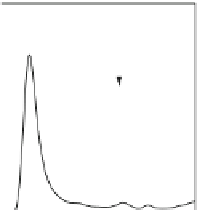Chemistry Reference
In-Depth Information
a
b
5
(Pt-Pt)
E
exc
=
1.96 eV
E
CT
5
4
4
4
4
3
(Pt-I)
(Pt-I)
3
2
3
1
0
2
120
Raman
Shift
100
80
0
100
200
2
T (K)
(cm
-1
)
296K
R'=H
3
N(C
6
H
12
)NH
3
,
n=0
1
1
R'=H
3
N(C
6
H
12
)NH
3
,
n=0
0
0
E
exc
=
2.41 eV
(Pt-Pt)
15
1
3
(Pt-I)
10
2
0
R=
(C
2
H
5
)
2
NH
2
,
n=0
120
Raman
shift
100
80
0
100
200
T (K)
2
(cm
-1
)
R=(C
2
H
5
)
2
NH
2
, n=0
5
1
0
0
1
2
3
4
5
0
100
200
300
Photon Energy (eV)
T (K)
Fig. 11.3 (a) Optical conductivity spectra with light polarization parallel to the chain axis in the
[(C
2
H
5
)
2
NH
2
]
4
[Pt
2
(pop)
4
I] and [H
3
N(C
6
H
12
)NH
3
]
2
[Pt
2
(pop)
4
I], and Raman spectra (inset) for the
polarization of
z
(
xx
)
z
(
x
//chain axis). (b) Temperature dependence of
w
spin
and 1/
w
spin
(insets).
Broken lines
represent Curie components
stretching mode of the Pt-Pt unit. The splitting of this mode indicates the formation
of two kinds of Pt-Pt units, in this case Pt
2+
-Pt
2+
and Pt
3+
-Pt
3+
. The ground state of
[H
3
N(C
6
H
12
)NH
3
]
2
[Pt
2
(pop)
4
I] can therefore be considered to be CDW state. In
[(C
2
H
5
)
2
NH
2
]
4
[Pt
2
(pop)
4
I], this Pt-Pt stretching Raman mode is a single band,
suggesting that the ground state is CP state. The weak bands at around 110 cm
1
can be attributed to the Pt-I stretching mode, which is activated by the
displacements of I in both compounds.
The magnetic properties of the materials were then investigated to confirm these
assignments. The temperature dependence of
w
spin
(1/
w
spin
) is shown in Fig.
11.3b
.
In [H
3
N(C
6
H
12
)NH
3
]
2
[Pt
2
(pop)
4
I],
w
spin
follows the Curie law as shown by the
broken line in Fig.
11.3b
(the upper figure). Curie impurities make up 0.16 % per Pt
site. No paramagnetic components originate from the 1D spin chains. In
[(C
2
H
5
)
2
NH
2
]
4
[Pt
2
(pop)
4
I], on the other hand, the temperature dependence of
w
spin
cannot be explained by the Curie component alone.
w
spin
has a finite compo-
nent independent of temperature, which is attributable to a contribution from the 1D
spin chain. The result in Fig.
11.3b
(the lower figure) can be largely reproduced by
the sum of the Bonner-Fisher curve [
16
] with
J
~ 3,000 K (
J
: antiferromagnetic
interaction) and Curie component with the concentration of 0.34 % per Pt site. From
these comparative studies, it can be concluded that the ground states of
[(C
2
H
5
)
2
NH
2
]
4
[Pt
2
(pop)
4
I] and [H
3
N(C
6
H
12
)NH
3
]
2
[Pt
2
(pop)
4
I] are CP state and
CDW state, respectively.






































































































































































































































Search WWH ::

Custom Search